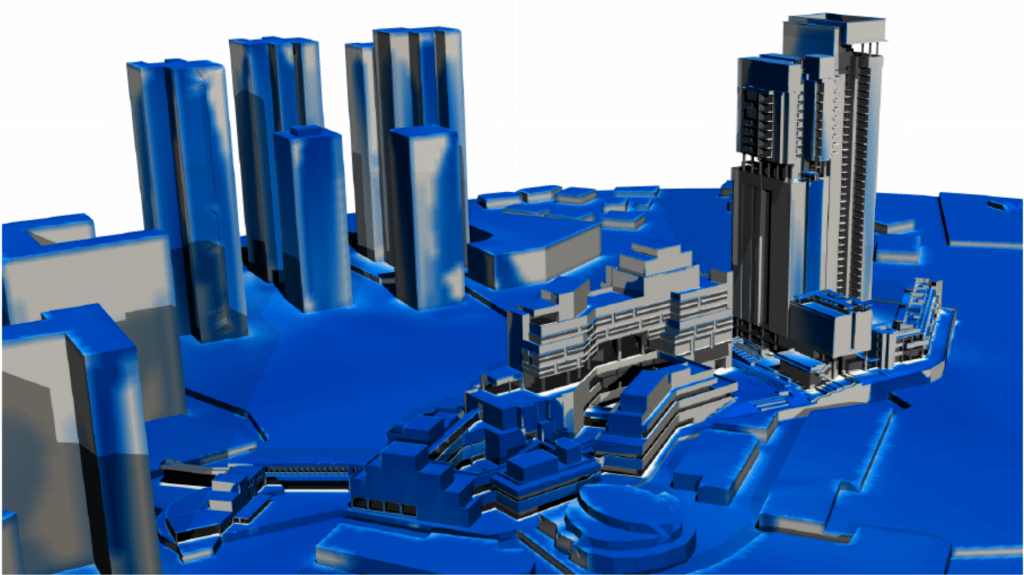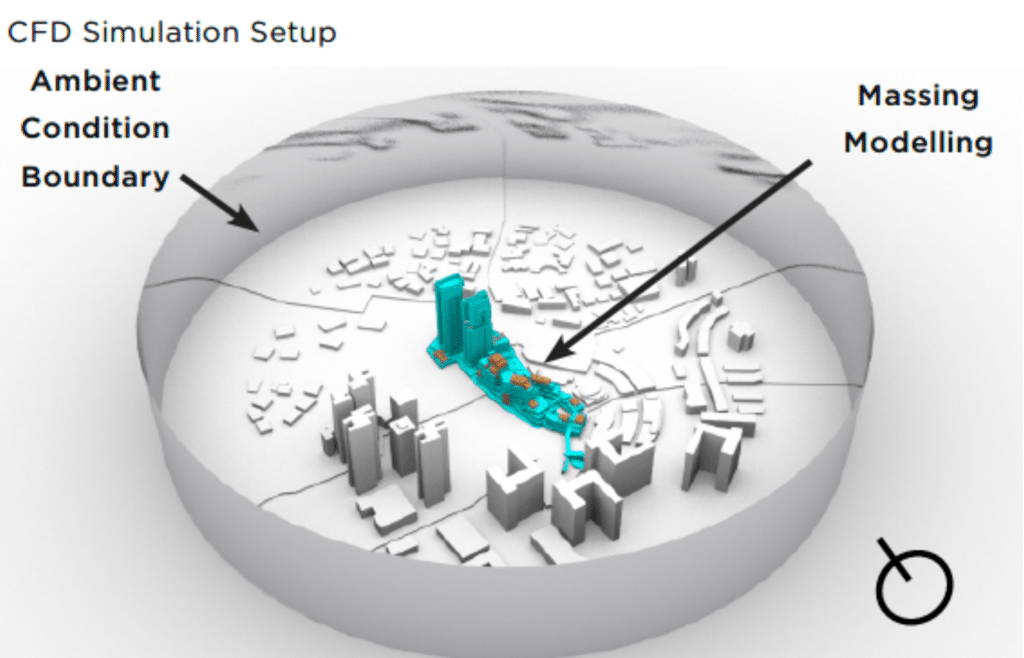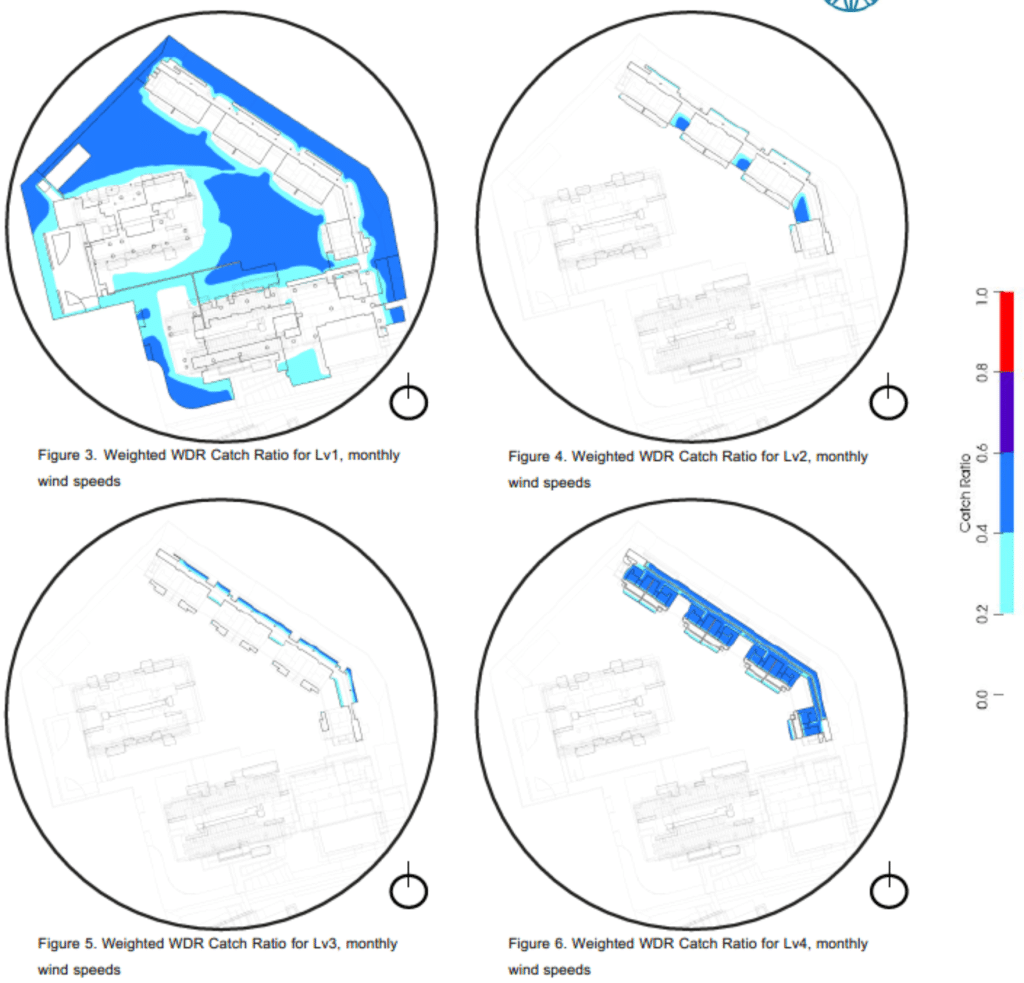Understanding the Impact of Wind-Driven Rain on Architectural Design: Insights from Windtech’s CFD Study Approach
Posted on January 24, 2024
In the realm of architecture and urban planning, the challenges posed by wind-driven rain (WDR) are often underestimated, leading to significant form and aesthetic consequences for buildings. This article delves into the critical role of Windtech’s Computational Fluid Dynamics (CFD) Wind Driven Rain studies in addressing these challenges, offering innovative solutions that revolutionize building design and occupant comfort.
The Overlooked Challenge of Wind-Driven Rain
The issues arising from neglecting WDR in architectural design are profound. Inadequate consideration of WDR can result in water infiltration, causing damage to building materials, building contents as well as infrastructure such as lifts and escalators. This results in reduced lifespan of structures, and increased maintenance costs. Moreover, it can significantly impact the comfort and well-being of occupants, especially in outdoor communal spaces as well as the viability of retail tenancies.
The Power of CFD in WDR Analysis
Windtech utilises advanced Computational Fluid Dynamics modelling to accurately simulate the complex interactions between wind, rain, and architectural structures. This technology allows for precise modeling of rain patterns and their impact on buildings under varied wind conditions. By employing CFD, architects and planners can pre-emptively identify potential problem areas in building designs.
Assessing Wind-Driven Rain Effects
Windtech’s CFD studies include accounting for wind speed, wind direction, rain intensity, and the specific architectural features of a building. These elements are crucial in creating accurate models that predict how rain will interact with a structure, thereby enabling more informed design decisions. The key assessment points are as follows:
1. Areas of Concern: Areas on concern are identified and confirmed with the key stakeholders, these may include entrances, terraces, balconies and covered public spaces.
2. Climate analysis: A detailed statistical wind driven rain model is developed for the regions. This includes analysing the relationship between wind speed, wind direction, measured rainfall and rainfall intensity. This model is then refined to match wind conditions at the development site.
3. Simulation of WDR: The wind driven rain is simulated at the site. These simulations model the interaction between then wind and the rain. In these simulations a range of rain droplet sizes are included. The wind may significantly alter the raindrop trajectories, enabling rain to bypass traditional barriers such as overhangs and awnings. Wind can drive rain horizontally (or even upwards, depending on the wind’s velocity and direction) into seemingly protected areas like covered terraces and balconies.
4. Visualizing Wetted Surface Area: The report presents cumulative Wetted Surface Area contours to visualize surface wetting and rain accumulation under canopies and awnings at ground level under different wind conditions. These figures are easy to interpret and summaries the results of multiple simulations.
5. Mitigations Measures: If required mitigation measures can be designed and tested using these results
Case Study: One Holland Village, Singapore
The Windtech CFD Wind Driven Rain Study for the One Holland Village project in Singapore provides a detailed analysis of the effects of wind-driven rain on the development. The study utilized Computational Fluid Dynamics (CFD) to model and analyze the impact of rain in combination with various wind directions on the structure. Key findings from the study include:
1. Lower Levels Analysis (Levels 1 to 4): The study found that wind-driven rain would be concentrated in sections lacking local shading or overhangs. Areas fully exposed were likely to see moderate rain accumulation, with variations across different wind directions.
2. Elevated Terraces Analysis (Levels 20 and 33): Rain accumulation levels at elevated terraces were strongly correlated with wind direction. The study provided detailed insights into how different areas of these terraces would be affected by rain under various wind conditions.
To address these issues, the study recommended design modifications. These included the implementation of architectural features such as overhangs, screens, or shelters in areas where rain accumulation was predicted to be high. By incorporating these elements, the design aimed to reduce rain penetration into vulnerable areas, thus enhancing the overall functionality and comfort of the building’s spaces. This approach exemplifies how targeted design interventions, informed by
detailed CFD analysis, can effectively mitigate wind-driven rain impacts in urban structures.
Windtech’s Unique Approach
In the field of wind-driven rain (WDR) assessment, Windtech sets itself apart with a distinctive performance-based approach. This method is a testament to our commitment to leveraging cutting-edge technology and research in the CFD industry. At Windtech, we utilize the latest published methods and incorporate our own proprietary techniques and tools, ensuring our analysis aligns with current world best practices.
The cornerstone of our methodology is the integration of comprehensive environmental data, advanced CFD modeling, and our proprietary algorithms. This combination enables us to accurately simulate real-world scenarios, providing detailed insights into potential WDR impacts. Our approach goes beyond mere prediction; it offers actionable recommendations for design modifications that can effectively mitigate WDR effects.
Concluding Thoughts
Incorporating Windtech’s CFD Wind Driven Rain Study into the design process brings numerous benefits. It leads to structures that are not only visually appealing but also functionally robust against the challenges of wind-driven rain. This approach ensures the longevity of buildings, enhances the comfort of occupants, and promotes sustainable architectural practices.
In conclusion, the Windtech CFD Wind Driven Rain Study is an indispensable tool in modern architecture, offering innovative solutions to the challenges faced in urban environments, particularly in regions prone to intense and frequent rainfall. By embracing such advanced methodologies, Windtech positions itself at the forefront of wind engineering, setting a new standard in the design and sustainability of urban structures. This innovative approach not only addresses the immediate concerns related to WDR but also paves the way for future advancements in architectural resilience and sustainability.
Return to Main News Page




